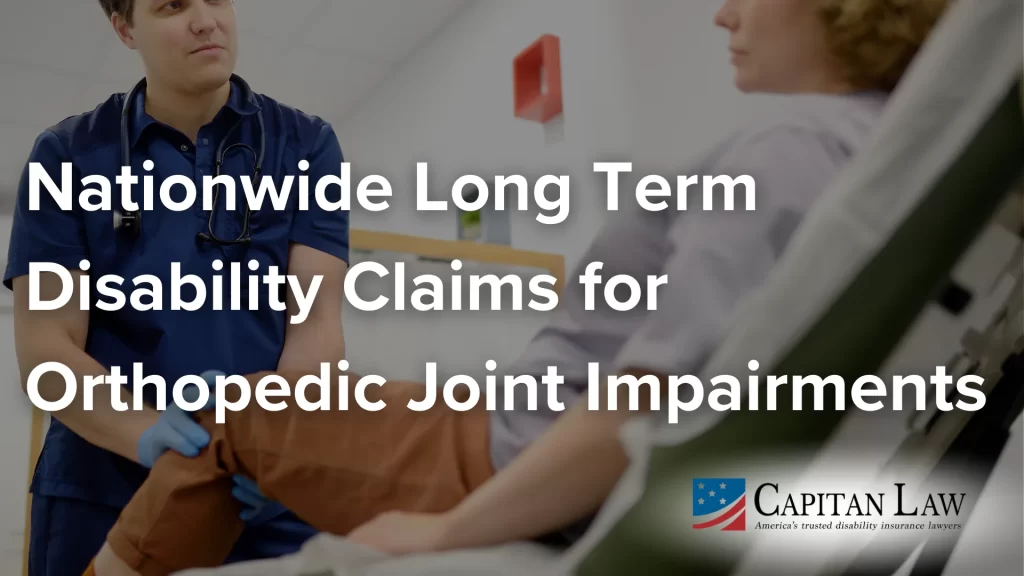 Do you experience severe joint pain or joint impairments? Do your joint impairments prevent you from performing daily activities or working? If so, you may be entitled to long-term disability benefits to help you manage the impact of your condition.
Do you experience severe joint pain or joint impairments? Do your joint impairments prevent you from performing daily activities or working? If so, you may be entitled to long-term disability benefits to help you manage the impact of your condition.
Joint impairments can cause severe pain, even during basic daily tasks. It can make it impossible for you to continue working, especially if your job is physically demanding. Losing your income because of a medical condition is something no one wants to experience. Even if you’ve planned for the future and have substantial savings, your money may not be enough to provide for yourself and your future indefinitely.
You and your family should never have to suffer from serious financial strain because you’re physically unable to perform your job. Fortunately, long-term disability (LTD) insurance can provide financial assistance if an orthopedic joint impairment prevents you from working.
An LTD insurance policy helps make sure that you don’t lose all of your income because of a physical disability. But filing for LTD benefits can be difficult and time-consuming. Even one error in your claim could prevent you from receiving the money you deserve.
When you file an LTD claim, you need a skilled attorney by your side to help you get your benefits as soon as possible. The long-term disability attorneys at Capitan Law are ready to help you with every part of your LTD claim. Take the first step to getting the benefits you need by contacting Capitan Law at (267) 419-7888 right now.
Understanding the Joint Mechanism
Joints are places in your body where two bones come together. They’re comprised of multiple different types of tissue, including cartilage, tendons, and ligaments. These tissues create a protective cushion between the bones and stabilize your movements. When they work properly, they keep your body safe and allow you to move smoothly.
You have a combination of fixed and mobile joints. Fixed joints keep two bones locked in place. Examples include the places where the bones in your skull meet. Mobile joints, on the other hand, allow your body to move at the location where two bones meet, such as the elbow or knee.
Mobile joints allow for a specific range of motion, based on the construction of the joint. The four types of mobile joints in your body are:
- Ball-and-socket joints: These allow for rotational movement as well as forward, backward, and sideways movements. Your shoulders and hips are examples of ball-and-socket joints.
- Pivot joints: They allow limited rotation. Pivot joints are located primarily in your neck and back.
- Hinge joints: These kinds of joints allow for bending motions. They’re responsible for movement in your knees, elbows, and fingers.
- Ellipsoidal joints: They allow for all movements except pivoting. Your wrists move using ellipsoidal joints.
You should experience no pain while moving within your normal range of motion when your joints are healthy and intact. With age or disease, the bone and tissue at your joints may deteriorate, causing extreme pain and limited mobility.
Common Causes of Orthopedic Joint Impairment
Chronic joint pain, difficulty moving, or stiffness at your joints are all symptoms of orthopedic joint impairments. These symptoms are caused by a wide variety of disorders and illnesses that can seriously impact the health of your joints.
Some of the most common causes of joint impairments include:
- Osteoarthritis – a disorder that causes irreversible degeneration of the protective cartilage in your joints
- Rheumatoid arthritis – an autoimmune disorder in which the immune system attacks your body tissue, resulting in chronic joint inflammation
- Gout – a build-up of uric acid in the blood which causes attacks of pain, swelling, and redness at the joints
- Bursitis – inflammation of the fluid sacs that protect your joints, typically due to repetitive motion or overuse
- Septic arthritis – a painful joint infection that can cause the cartilage and bone in your joints to deteriorate which often stems from staph infections or a bone infection called osteomyelitis
- Tendinitis – inflammation and irritation of your tendons near the joints also commonly called tennis elbow, swimmer’s shoulder, and jumper’s knee
Speak with your doctor to identify the source of your pain as soon as possible to effectively manage your orthopedic joint impairment. They will create a targeted treatment plan to help you reduce your joint pain and increase your overall mobility.
Unfortunately, there’s no cure for most joint impairments. Pain management and physical therapy can greatly improve your quality of life, but you may still need support from LTD insurance.
Types of Orthopedic Joint Impairments
A joint impairment can cause severe limitations to the activities you can perform. You may experience impairments in any of the joints in your body.
Some of the most common types of joint impairments include:
- Shoulder, Elbow, and Wrist Impairments: These impairments are often the result of rheumatoid arthritis, bursitis, or tendinitis. They may limit your ability to perform tasks such as lifting or moving objects, reaching for objects above your head, writing or typing, and using power tools.
- Hip Impairments: They typically result from osteoarthritis, rheumatoid arthritis, bursitis, or septic arthritis. Hip impairments may limit your ability to sit or stand for long periods, walk, jog, or lift heavy objects.
- Knee Impairments: They are commonly caused by osteoarthritis, rheumatoid arthritis, bursitis, septic arthritis, or tendinitis. If you experience knee joint impairments, you may have difficulty standing or walking, bending to the ground, or using stairs.
- Ankle and Foot Impairments: These kinds of impairments are often caused by rheumatoid arthritis, gout, or tendinitis. They may limit your ability to walk, run, jump, or carry weight.
Many joint impairments make workers unable to complete the tasks required in their job because of serious disability. The combination of chronic pain and limited mobility can completely alter your life and your abilities. If you suffer a joint condition like this, you and your loved ones shouldn’t have to suffer financial strain because of it.
When Can I File for LTD Benefits?
Even after your diagnosis of orthopedic joint impairment, you may have to wait to apply for long-term disability benefits. Most LTD insurance policies include an “elimination period,” which determines how long you must be unable to work before you’re eligible to receive benefits.
The elimination period can last between three and 26 weeks, depending on the terms of your policy. In most cases, the less you pay on your insurance premium, the longer your elimination period.
If you purchase LTD insurance from your employer, your policy may have additional specifications that determine when you can apply for LTD benefits. It might require you to have worked at the company for a specific length of time.
Before you file a claim, review your policy carefully with a long-term disability attorney. Your lawyer will help you understand the restrictions and regulations which may impact your eligibility for benefits.
Why You Need an Attorney
 Orthopedic joint impairments often require treatment throughout your life in order to manage the severe disorder. Even with the right doctor and the right treatment plan, you might still be unable to eliminate debilitating symptoms that impede your professional and personal life.
Orthopedic joint impairments often require treatment throughout your life in order to manage the severe disorder. Even with the right doctor and the right treatment plan, you might still be unable to eliminate debilitating symptoms that impede your professional and personal life.
Although you and your doctors understand the complexities of your joint impairment, your LTD insurance provider may not. You’ll have to submit extensive evidence to document your disorder and the impact it has on your life to receive LTD benefits. Gathering this can be incredibly time-consuming, especially when you don’t know all which documents you need to build a strong LTD claim.
Your long-term disability attorney will simplify this process, so you can save time, focus on your treatment, and rest in the knowledge that you have the best chance of receiving the benefits you deserve. At Capitan Law, our LTD lawyers will collect and organize all of the documents you need for your claim. They’ll also gather statements from your medical team that explain the severity of your condition and the limitations you face fully in a way the insurer will understand.
When you work with a long-term disability lawyer, you’ll know what information you need to provide for your claim and avoid the errors that could seriously jeopardize your right to benefits.
Why Choose Capitan Law
The attorneys at Capitan Law have represented long-term disability clients across the country, so we have an in-depth understanding of LTD laws in every state. No matter the complexities that come with your LTD claim, the lawyers at Capitan Law are ready to fight for you.
Capitan Law understands that every case is different, and we believe you deserve a lawyer who will create a legal argument that fits your needs. Our lawyers take the time to get to know you and your case so that we can personalize our approach and help you receive the best possible outcome.
When you work with Capitan Law, you become a member of our family. We’ll fight for you and do everything in our power to help you receive the benefits you deserve.
Contact Capitan Law Today
The long-term disability attorneys at Capitan Law are ready to provide you high-quality legal counsel during your LTD claim. You need your benefits as soon as possible, so we won’t rest until you get the money you need. Take action on your LTD claim today by contacting Capitan Law at (267) 419-7888 right now.